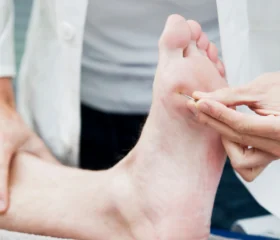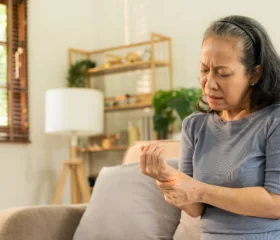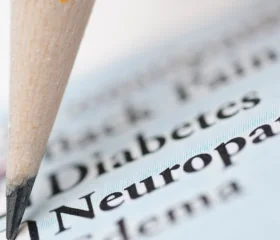Surviving DKA: My Journey of Misdiagnosis, Resilience, and Advocacy

Navigating the challenges of diabetes can be unpredictable and, at times, life-altering. In this article, we share the story of Jackie Barlow Lovoi, whose journey with diabetic ketoacidosis (DKA) reveals the critical importance of resilience, accurate diagnosis, and self-advocacy. From a life-changing emergency room visit that shifted her understanding of her diagnosis to repeated encounters with DKA, Jackie’s experience highlights the complexities of managing diabetes and the vital role of support systems, technology, and community. Read about how Jackie reflects on her path from misdiagnosis to advocacy, shedding light on the courage it takes to live well with diabetes every day.
I will never forget my first encounter with diabetic ketoacidosis (DKA). Roughly nine months after being diagnosed with type 2 diabetes, I landed in the same Boston Emergency Room with a set of symptoms that were different, but no less concerning. For weeks, my co-worker had urged me to see a doctor, saying that something was “just not right” with me. While I normally walked 3 miles a day back then, walking down the hall became labored in steps and breathing. At first, I chalked it up to staying up late to watch the Summer Olympics. I finally became concerned after losing six pounds in four days despite eating nonstop and being ravenously hungry. When vomiting and exhaustion set in, I hailed a cab after work for the 2-mile ride to the hospital.
Hearing the doctor say “DKA” about my condition was downright confusing. I thought he said I was decaying! Chalk it up to the Boston accent, I suppose. I was relieved to find out that I wasn’t decaying, but the truth of my condition was a cold comfort. “Diabetic ketoacidosis is not something type 2 patients typically experience,” I heard the ER doctor say. He informed me that my diagnosis nine months prior was perhaps not accurate, and I could be living with type 1. This was years ago, and today I’d likely be diagnosed with type 1.5 (LADA). In any case, it was all so confusing to me.
Unfortunately, none of my family members were with me during this jarring bedside visit, and my head was swimming. I thought only children were diagnosed with type 1, and I was a 43-year-old woman! It did not compute. As if all of this wasn’t unusual enough, there was a camera crew in the ER that day who came in and asked me if I’d sign a release form. My ER encounter ended up on a popular Boston nightly news show. Truth is stranger than fiction!
Prior to this, I had never heard of DKA, let alone the treatment for it. The doctor explained that I was being put on an insulin drip to bring down my blood glucose. There were IVs of electrolytes because mine were nowhere near the normal range. I also had to supplement my Magnesium with a drink mixture because it was so out of range. That drink tasted awful, but I knew it was a necessary evil. I was discharged three days later with prescriptions for syringes and insulin, and I made an appointment with an endocrinologist. Life as I knew it had changed in an instant with my new diagnosis.
I wish I only had DKA that once, but such was not the case. I had DKA twice more.
Facing DKA Again: The Power of Support
My second DKA case came on a Saturday morning when I found myself staring down at a burgundy color on my ketone strip. Ketone urinalysis strips measure the ketones in urine, and the darker the result, the higher the number of ketones, which can lead to a DKA diagnosis. The burgundy I saw was not good, not good at all! I alerted my husband, Brad, who is about the best partner I could have in this crazy life with insulin-dependent diabetes. Without hesitation, off to the ER we went, where I stayed for 3 days. Treatment was largely the same, with insulin and IV electrolytes. I felt as good as new in a few days.
My third DKA case ruined a visit with a good friend who was visiting from Vermont. Instead of grabbing dinner and catching up, she had to drive me in my car to the ER in Cambridge, where I was admitted with DKA. I knew right away what it was – I was weak, confused, and just wanted to sleep. The nausea I felt and my elevated blood glucose levels were also signs of DKA.
This third (and last) experience with DKA was due to a malfunctioning insulin pump, which caused my glucose to soar to over 1000! Usually, I have a prescription for short-acting insulin pens, but it had expired. Since I had an appointment with my endocrinologist the following week, I decided to get a new prescription during my visit. My only saving grace was that I knew all the signs of DKA and that I needed help.
That particular hospitalization brought the challenge of trying to hide the fact that I was in the hospital from my mother, who was battling brain cancer and would have wanted to make the trip from Pennsylvania to Boston to see me. I knew I would be fine in a day and that she wasn’t well enough to travel. I asked my nurse to disconnect me from everything that beeped while I did my daily morning call with my mother, acting as if it were any other day. My nurse understood and unhooked me for the short daily charade. I hoped that a doctor wouldn’t breeze in and loudly announce themself during one of these calls, and I’m thankful that I successfully pulled off that ruse.
Finding My Voice and Embracing Diabetes Technology
Self-advocacy wasn’t taught or modeled – I learned from my DKA experiences. Advocacy can be a slippery slope and may be more difficult for women. Advocate too much, and you’re branded as demanding and unreasonable. Don’t advocate at all, and be prepared to accept what you get, which can sometimes be subpar. These are hardly appealing choices, but the answer doesn’t lie in such extremes. The answer is not to stay silent about your health. There are no mind readers, so it’s up to you to provide a map to show people how to treat you, help you, and support you. That’s not weakness, that’s strength!
The biggest factor for me in preventing DKA has been a continuous glucose monitor (CGM). I experienced all of my DKA incidents prior to using CGM. My relationship with this device started as a love-hate relationship (or a hate-hate relationship, to be honest), but I consider it an invaluable, life-saving tool in my diabetes management journey.
I keep waiting for the day when my blood glucose is perfect. There is no one-size-fits-all measure for target glucose range; it is a highly personal thing, and my goal is different from someone else’s. Knowing how close or far I am from my target A1C drives the daily, hourly, minute-by-minute work I do to manage diabetes.
Along with a CGM, it takes the right tools, skill sets, and experience to do my best to avoid DKA. It DOES get easier! Another thing that has helped me in recent years is the various diabetes online communities. DiabetesSisters is a very empowering group of women supporting each other. There are resources out there – avail yourself of them!
About the Contributor
Jackie Barlow Lovoi lives with type 1.5 diabetes (LADA). A former Special Educator, Jackie is an Executive Assistant at Texas Instruments in Waltham, MA, and has decades of administrative experience with Fortune 500 companies, startups, and higher education. She lives outside of Boston, MA, with her husband, Brad. In her free time, she enjoys hiking, participating in diabetes online communities, traveling, and spending time with friends.
Written by






